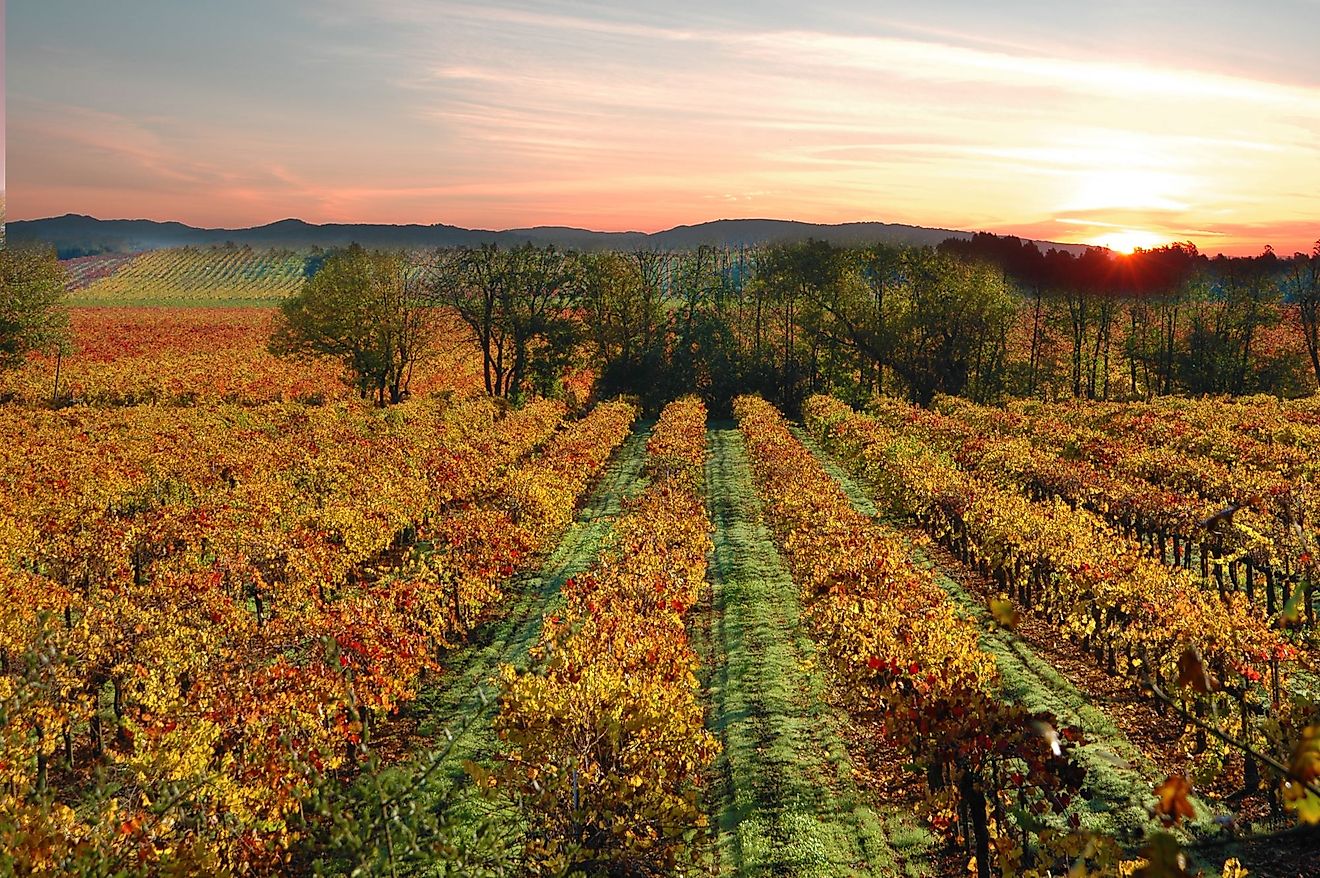California is the nation’s gold standard for viticulture, with two world-famous wine regions. Both the Napa and Sonoma Valleys lie within an hour of San Francisco. Sebastopol lures free-spirited wine enthusiasts, as does nearby Guerneville, synonymous with the great outdoors at the heart of Armstrong Redwoods State Natural Reserve. From the flamboyant Yountville to the official birthplace of Napa’s wine industry, St. Helena, which wine lover’s paradise speaks to you?
Calistoga
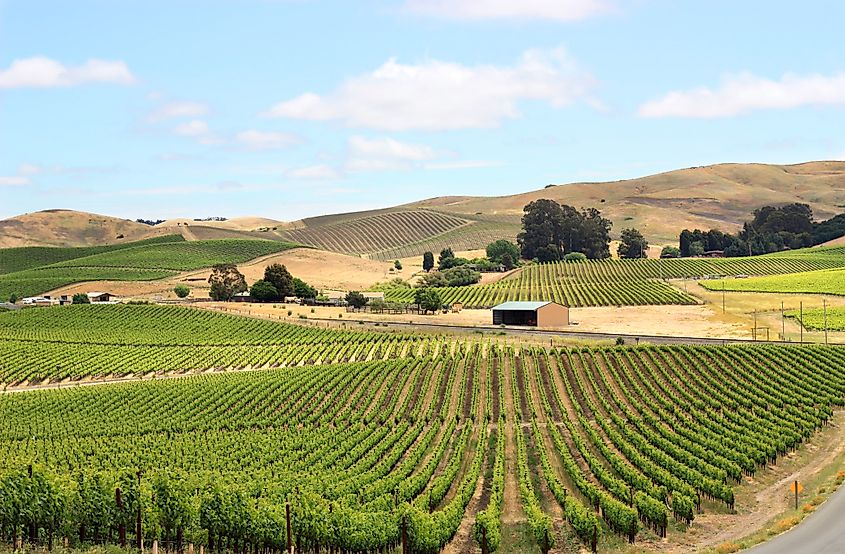 Vineyards near Calistoga, California.
Vineyards near Calistoga, California.
Over 500 years ago, the Wappo tribe discovered ancient springs. Today, the Napa Valley’s northernmost town has a mellow, bubbly personality, like its natural hot spring and sparkling wines. You can reflect on the deep heritage at Indian Springs, one of the state’s original spa resorts, with midcentury appeal and an Olympic-sized spring-fed pool.
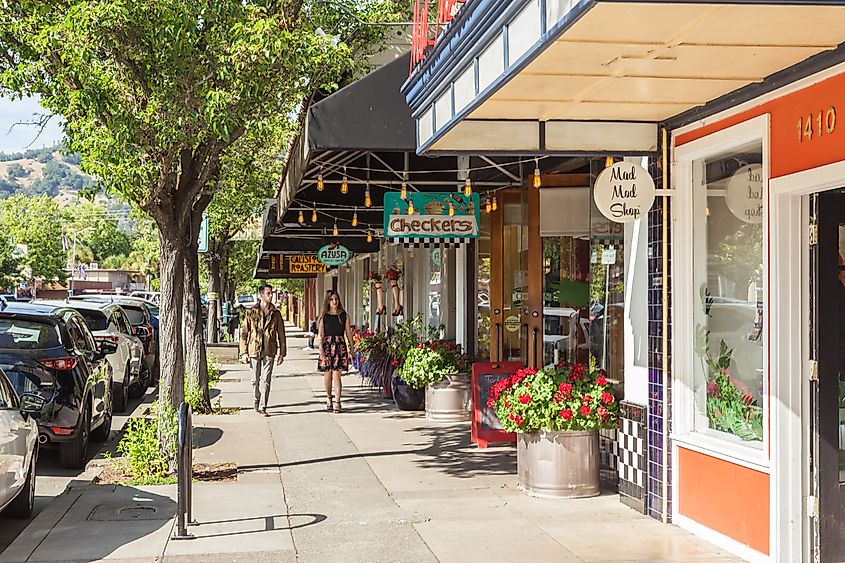 Buildings on the streets of historic Calistoga, California. (Image credit Dragan Jovanovic via Shutterstock)
Buildings on the streets of historic Calistoga, California. (Image credit Dragan Jovanovic via Shutterstock)
Wrapped in mountains to the east and west, Calistoga is ideal for relaxing, with a slower pace and scenic views, and without the extravagance of some other towns in the valley. In addition to spas, B&Bs, and even Roman-style bathhouse experiences, Calistoga offers idyllic vibes and unique sites, like the Old Faithful Geyser of California. Castello di Amorosa is a real gem of the valley on a tour. The authentic medieval-style winery is set in a castle and offers Italian-inspired wine tastings.
Guerneville
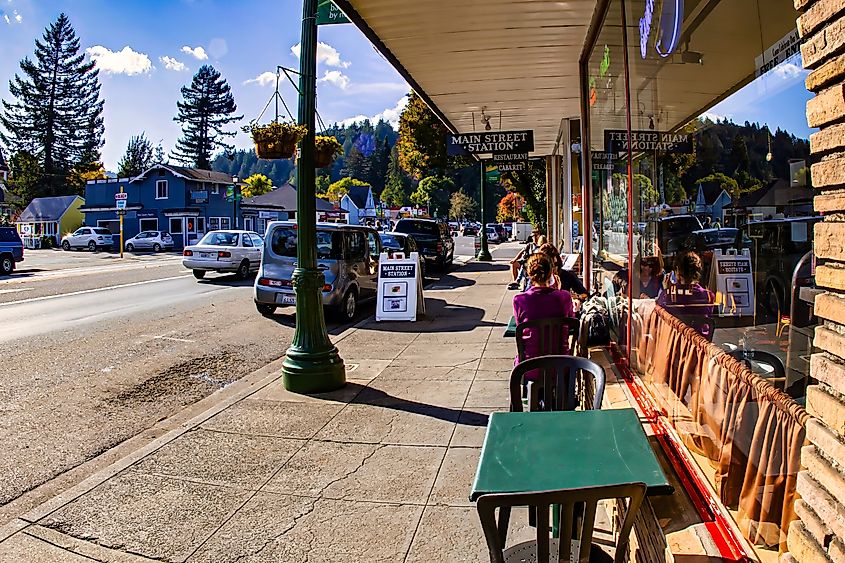 Visitors enjoy coffee outside a cafe on Main Street in Guerneville, California. Image credit: oliverdelahaye / Shutterstock.com.
Visitors enjoy coffee outside a cafe on Main Street in Guerneville, California. Image credit: oliverdelahaye / Shutterstock.com.
Guerneville is named for the sawmill owner, George Guerne, and these early settlers are commemorated during the annual Stumptown Daze parade. The town was developed in the 19th century on the edge of the redwood forest, now the Armstrong Redwoods State Natural Reserve. The wooded 805-acre grove embraces ecotourists in magic. The 1,400-year-old Colonel Armstrong is the oldest tree in the forest, while Parson Jones is the tallest, at over 300 feet tall, making you feel like you are in the company of living giants.
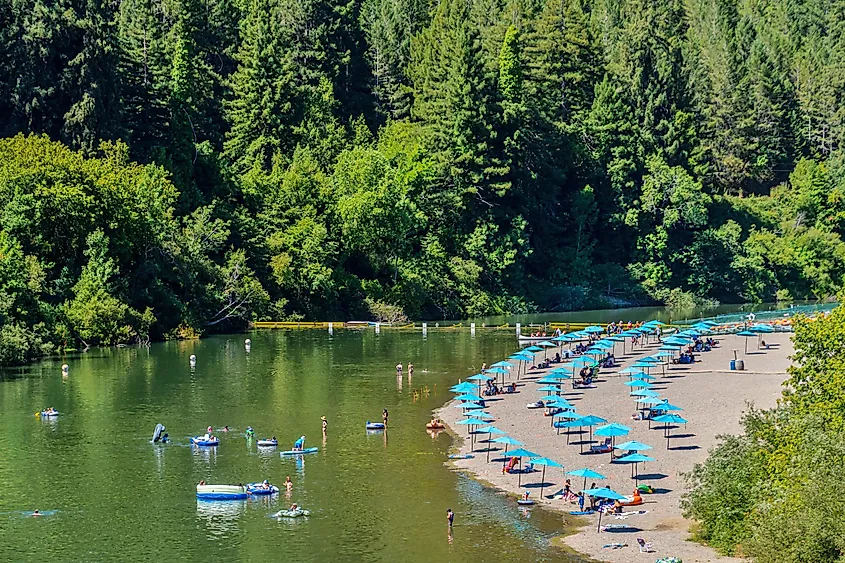 Johnson’s Beach, Guerneville, California, on the Russian River.
Johnson’s Beach, Guerneville, California, on the Russian River.
After some fun in the sun at the pebbled Johnson’s Beach, keep the good vibes going at the 19th-century Korbel Winery, known for champagne, with guided walks and tastings. Since an influx of artists in the ’70s, Guerneville has become a cultural beacon, with venues like the Russian River Art Gallery displaying work by local makers and celebrating the region’s creative spirit.
Sebastopol
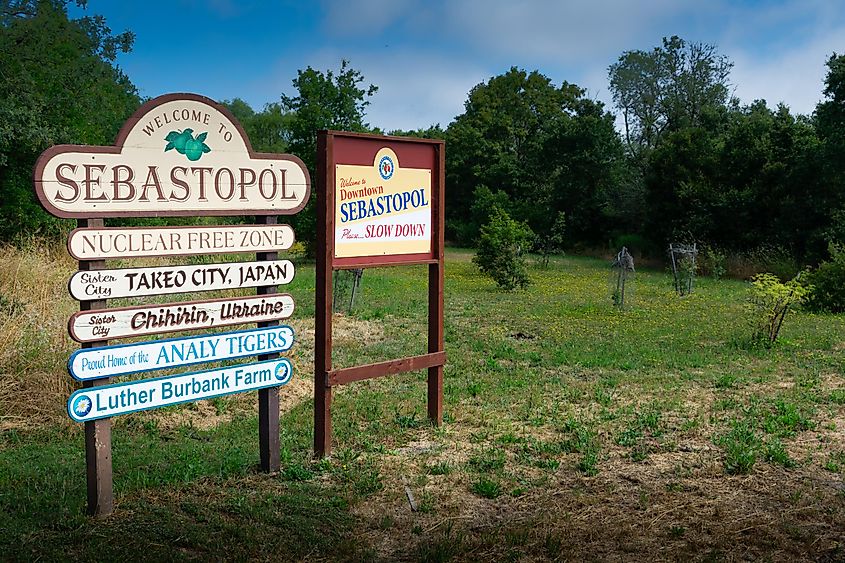 Welcome to Sebastopol
Welcome to Sebastopol
Founded on farming in the 1850s, Sebastopol is just 15 miles from the Pacific in northwestern Sonoma County and 18 miles south of Armstrong Redwoods State Natural Reserve. The once-known Gravenstein Apple Capital of the World, with booming orchards and canneries in the early 1900s, has since replaced many of them with vineyards, wineries, and cideries, including Ace Cider, independently owned and handcrafted since 1993.
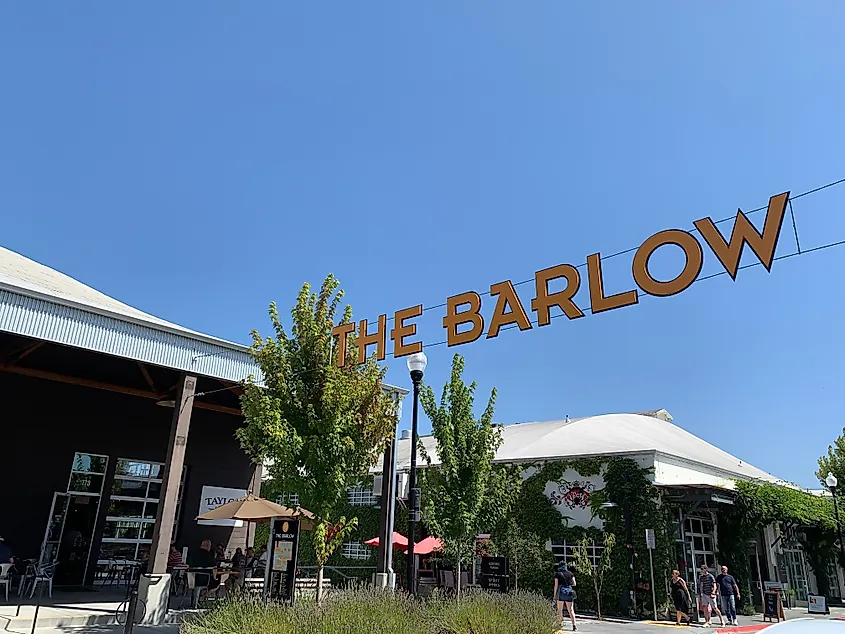 The Barlow. (JudeAnd / Shutterstock.com)
The Barlow. (JudeAnd / Shutterstock.com)
The Barlow is an industrial-chic marketplace on the site of a 1939 applesauce cannery, with shops, galleries, and dining in a dog- and kid-friendly space. Beyond the reds, whites, and bubbles, tourists enjoy the outdoors as voluminous as the endless sea and the world’s tallest trees. You can drive to the coast at sunset and score some easy-care plants from California Sister in nearby Santa Rosa for a memorable souvenir.
Sonoma
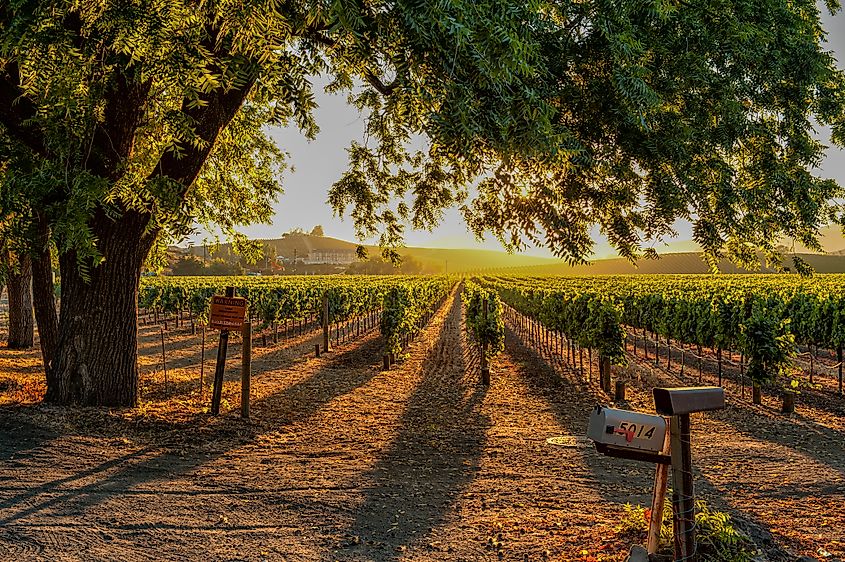 A stunning sunset over the Sonoma wine country in California
A stunning sunset over the Sonoma wine country in California
This extremely walkable 2.7-square-mile town played a pivotal role in California’s history. At the Sonoma State Historic Park, you can learn about the 1846 revolt when insurgents captured Sonoma from the Mexicans. Soon after they raised the flag of the short-lived California Republic, the US Army arrived, pushing for the annexation of California. No wonder Sonoma is the heart and namesake of the valley.
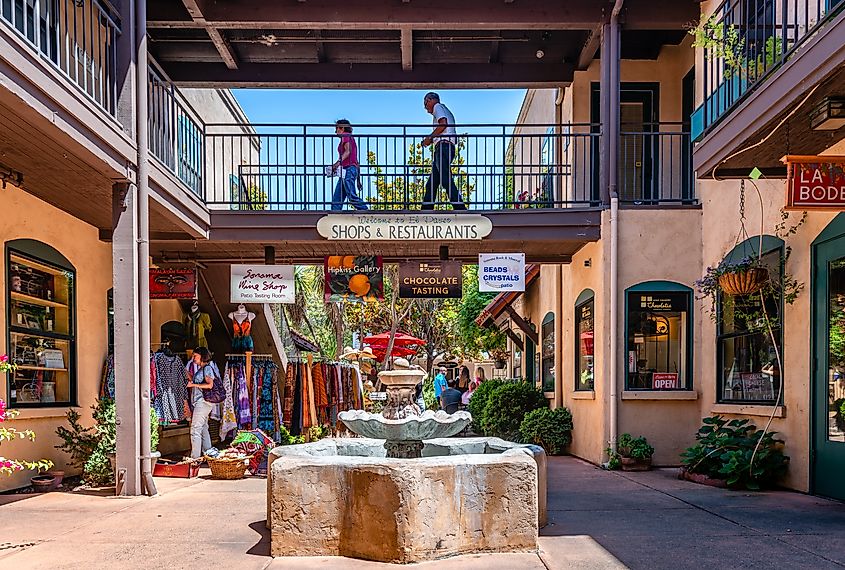 The courtyard of El Paseo de Sonoma, a shopping center in Sonoma, California. Image credit: Apostolis Giontzis / Shutterstock.com.
The courtyard of El Paseo de Sonoma, a shopping center in Sonoma, California. Image credit: Apostolis Giontzis / Shutterstock.com.
Historic Sonoma Plaza is marks the site of the “Bear Flag Revolt” with a sculpture. It is a festive place, particularly during the Tuesday Night Farmers Market from May through September. From the 1823 Mission San Francisco Solano, the last and northernmost of the state’s Spanish missions, to the residence of Sonoma’s founder, General Vallejo, some historic buildings live on as upscale shops and restaurants. The girl & the fig is one such hot spot that proudly serves quality French food using local products, and boasts a patio and an antique bar.
St. Helena
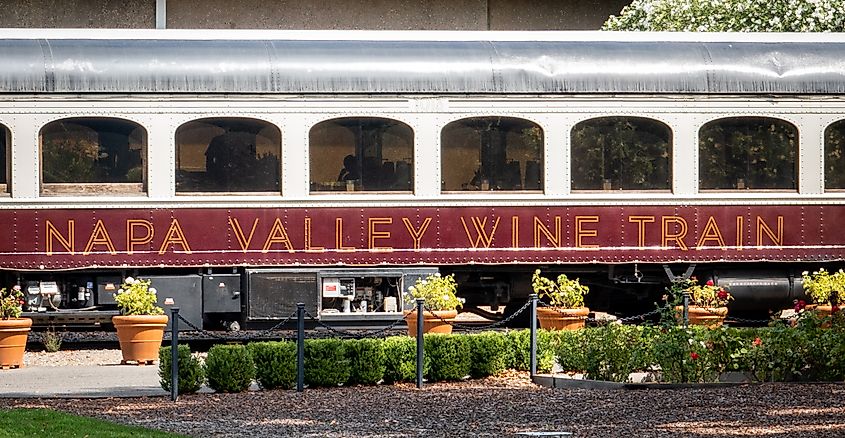 The Napa Valley Wine Train in St. Helena, California.
The Napa Valley Wine Train in St. Helena, California.
Once the center of social activity for the nearby rural communities, the hustle and bustle was not wasted on St. Helena. Known as Napa Valley’s Main Street, the tree-lined town at the heart of Napa’s wine country is as busy as ever, surrounded by lush vineyards and elegant, family-owned wineries sprawling across hillsides dotted with gardens, olive trees, and more. Bale Grist Mill Historic State Park skirts the town to the north, where the 1846 water-powered mill is one of only two such mills remaining west of the Mississippi River.
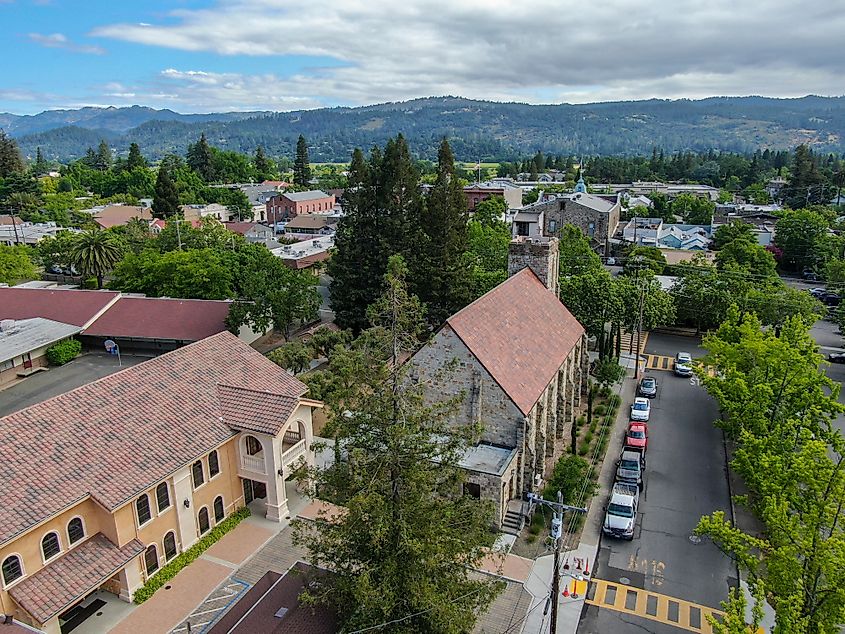 Aerial view of St. Helena, California.
Aerial view of St. Helena, California.
With the arrival of the railroad in the 1860s and the growing wine industry, St. Helena thrived as the commercial center. Tourists arrived by stagecoach to unwind at resorts, spas, and saloons. Today, Main Street overflows with high-end fashion boutiques, restaurants, galleries, and specialty shops. Amongst the antiquated stone and brick facades, The Richie Block is a Queen Anne-style building that stands across from the 1913 Cameo Cinema.
Yountville
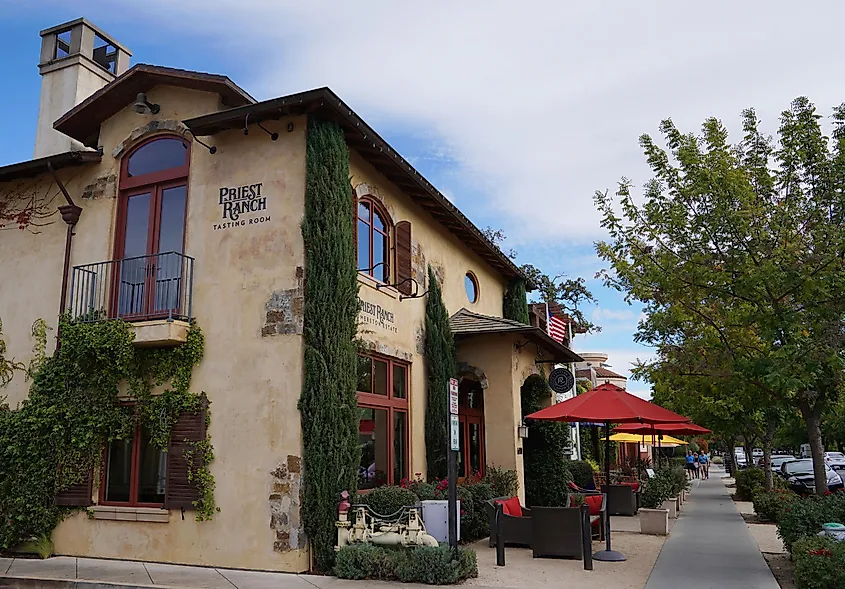 Priest Ranch Winery tasting room in the heart of Yountville, Napa Valley (via Leonard Zhukovsky / Shutterstock.com)
Priest Ranch Winery tasting room in the heart of Yountville, Napa Valley (via Leonard Zhukovsky / Shutterstock.com)
Thirty years before Charles Krug established the valley’s first commercial winery in St. Helena in 1861, George C. Yount planted the first grapevines in all of Napa Valley. He established Yountville just north of what is now the ritzy town of Napa. For a deeper dive into the region’s history, the Napa Valley Museum offers three galleries with a permanent collection on Napa Valley heritage.
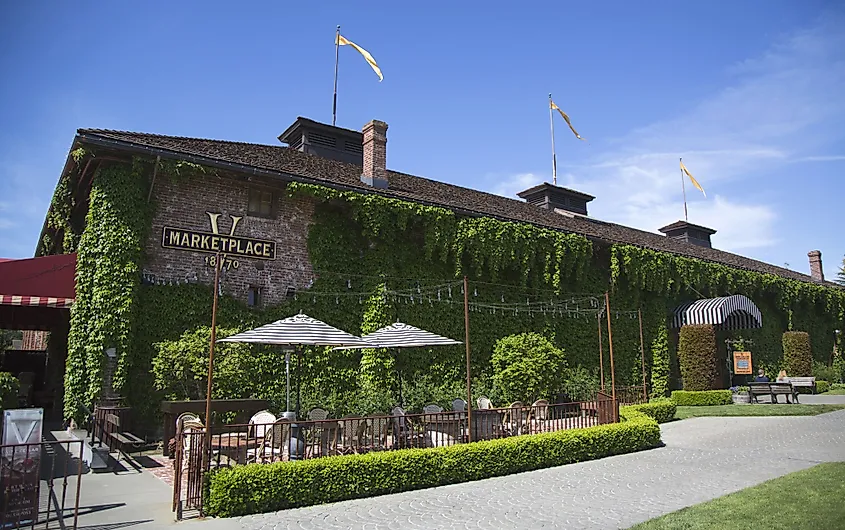 The historic V Marketplace in Yountville, Napa Valley, California. (Editorial credit: Leonard Zhukovsky / Shutterstock.com)
The historic V Marketplace in Yountville, Napa Valley, California. (Editorial credit: Leonard Zhukovsky / Shutterstock.com)
In 1973, the nation’s first French sparkling wine house in Yountville was the wine country’s pioneer fine dining restaurant. Chandon remains the town’s most-visited winery, known for its bubbles. For a true taste of the region’s finest, reserve a coveted table at Thomas Keller’s three-Michelin-starred restaurant, The French Laundry. No matter your budget, you can wander the outdoor sculpture collection that lines the Yountville Art Walk along Washington Street, with a map and audio guide available for download.
Though often pitted against each other, Napa and Sonoma boast diverse roots in favorable surroundings. Across the Bay Bridge, merging onto I-80, you’ll soon arrive in the Napa Valley, the land of Cabernet Sauvignon. While Napa can sometimes be over-the-top, Sonoma wine country is considered more relaxed. Known for its excellent Pinot Noir & Chardonnay grape varietals, which thrive in the cooler climate, Sonoma helped shape California’s history and continues to draw visitors to the region in droves. No matter how you slice it or sip it, these towns in California’s wine country are a must.

